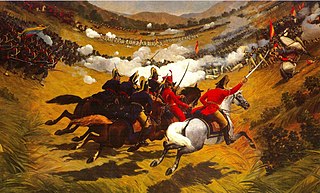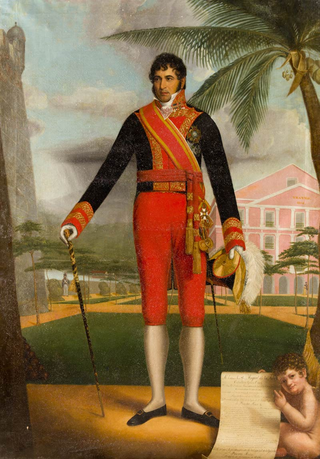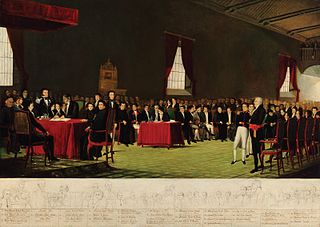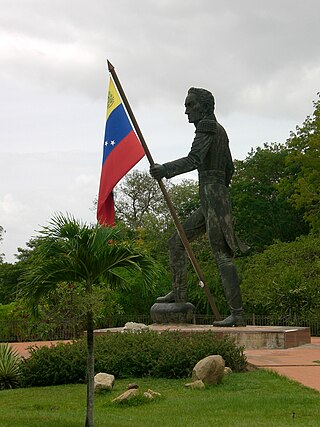
The Venezuelan War of Independence was one of the Spanish American wars of independence of the early nineteenth century, when independence movements in South America fought a civil war for secession and against unity of the Spanish Empire, emboldened by Spain's troubles in the Napoleonic Wars.

La Victoria is a city in the state of Aragua in Venezuela.

Manuel Carlos María Francisco Piar Gómez was General-in-Chief of the army fighting Spain during the Venezuelan War of Independence.

José Félix Ribas was a Venezuelan independence leader and hero of the Venezuelan War of Independence.

José Tomás Boves, was a royalist caudillo of the Llanos during the Venezuelan War of Independence, particularly remembered for his brutality and atrocities against those who supported Venezuelan independence. Though nominally pro-Spanish, Boves showed little deference to any superior authority and independently carried out his own military campaign and political agenda, even challenging Royalist norms by arguing for land ownership to pass into the hands of the pardos, mestizos, and Indigenous rather than the landowning elite.

Antonio Clemente José María Bernabé Ricaurte Lozano was a patriot of the Independence of Colombia and Venezuela and captain of Bolívar's army. He is remembered as the martyr of the Battle of San Mateo, where, in a heroic action, he blasted an enemy stronghold by immolating himself.

Juan Manuel Cajigal y Niño was a Spanish Captain General, born in Cádiz, in 1754.

Miguel de la Torre y Pando, conde de Torrepando was a Spanish General, Governor and Captain General, who served in Spain, Venezuela, Colombia and Puerto Rico during the Spanish American wars of independence and afterwards.
The First Battle of Carabobo (1814) was a battle in the Venezuelan War of Independence, in which the forces of the Second Republic, commanded by Simón Bolívar, defeated the Spanish forces under Field marshal Juan Manuel de Cajigal y Martínez.

The Battle of Los Horcones, part of the Admirable Campaign, was a military conflict in Venezuela during the Spanish American wars of independence fought on 22 July 1813 between the pro-independence forces led by José Félix Ribas and Spanish Royalist troops under colonel Francisco Oberto at the plain of Los Horcones. Ribas was victorious, capturing much of the Spanish equipment and more than 300 prisoners.
The Battle of Urica took place during the War of Venezuelan Independence in the village of Urica on 5 December 1814, between the forces of Republican general in chief José Félix Ribas and Royalist caudillo José Tomás Boves. Although Boves died, the Royalists won the battle.

The American Confederation of Venezuela was an unrecognized state located in the Captaincy General of Venezuela of the Spanish Empire, which was organized by Venezuelan patriots following the Venezuelan Declaration of Independence.
Student politics in Venezuela is the collection of students, largely university students, from across Venezuela participating in activism and developing political opinions. In Venezuela, student politicians hold a much larger clout than in many other countries, and many go on to be successful lawmakers in the nation.

The Venezuelan independence was the juridical-political process that put an end to the ties between the Captaincy General of Venezuela and the Spanish Empire. It also implied the replacement of the absolute monarchy by the republic as the form of government in Venezuela.

The Battle of San Mateo was a serie of battles in the Valleys of Aragua in what is now Venezuela, during the Venezuelan War of Independence between 28 February and 25 March 1814.
The Battle of Clarines took place during the Venezuelan War of Independence. Royalist forces attacked a north-bound force from the Third Republic of Venezuela near the town of Clarines. The outnumbered and poorly armed Royalists secured a victory against the Patriot rebels.

The Battle of Aragua de Barcelona was fought between Royalists of the Spanish Empire and the Second Republic of Venezuela on 17 August 1814. The battle saw Royalists attack Simón Bolívar's force of 3,000 and win with their 8,000 soldiers. It was a major loss for the Patriots.
The Second Battle of La Puerta was fought between Royalists of the Spanish Empire and the Second Republic of Venezuela on 15 June 1814. It was a crushing defeat for the Republicans and a turning point in the war that led to the fall of the Second Republic of Venezuela.
The Fifth Battle of Maturín was a military confrontation on 11 December 1814, that resulted in the epilogue of the Second Republic of Venezuela. The Royalist forces, which for two years had tried to conquer the city, destroyed the last great Patriot garrison that remained in the country.

The Second Battle of Angostura was a military siege and confrontation that took place in the context of the Venezuelan War of Independence between Patriot and Royalist forces, that ended with victory for the Patriots, who managed to capture the city of Angostura on 17 July 1817.














